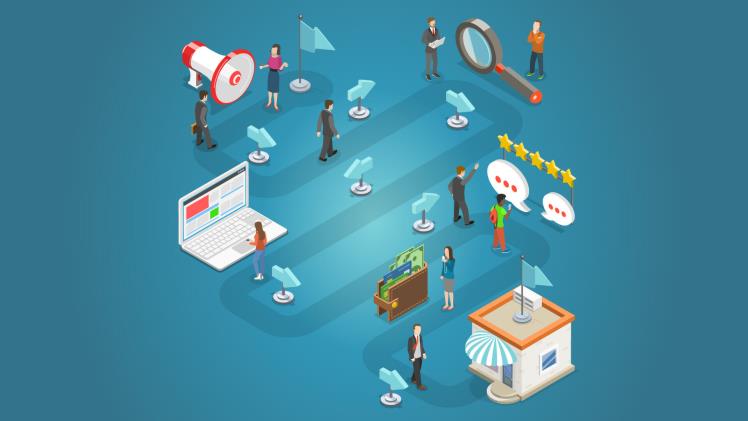Mapping the customer journey can optimize the customer experience and build customer relationships by identifying areas for improvement through visualization and collaboration.
Creating a compelling customer journey starts with understanding your personas and their goals. With regular updates, you can eliminate roadblocks and drive conversions.
Start with Personas
The key to creating a great customer journey map is ensuring you start with a clear understanding of your existing and future customers. Creating buyer personas will help you identify their goals and frustrations and guide your decisions regarding improving their experience.
It is recommended to use a cross-functional team to make your customer journey mapping process more effective. This approach helps to minimize the risk of “scope creep” and ensures that every team member has a unique perspective on each stage of your customer’s experience.
To start the process, it is essential to understand what motivates your customers and where they search for information. You can create an affinity diagram and brainstorm their needs for different journey stages. During the research phase, you can ask your customers where they search for product reviews and recommendations. Once you have gathered the necessary information, you can assess the results and determine what kind of feedback you need to provide.
Identify Touchpoints
While mapping out your customer journey, you must identify every touchpoint your company interacts with. It includes your website, social media, ads, third-party reviews, email communications, and more. Be sure to consider both direct and indirect interactions as well.
For example, if your customer is considering buying a product from you and is researching other options, this could be viewed as an indirect interaction. Indirect interactions are also significant because they may impact customer perceptions of your brand.
Once your customers have purchased and begun using your product, you want them to become a loyal advocate for your brand. It may include writing positive reviews, recommending the brand to friends and family, or participating in your loyalty program.
To achieve this goal, it’s critical to understand your customers’ emotional journey. This is why conducting surveys is so crucial. For instance, a simple questionnaire asking how happy your customers are with their purchases can help you determine if any roadblocks need to be addressed. It allows you to serve your customers better and reduces friction points that cause them to lose interest in your brand.
Organize Touchpoints by Stage
Customer journey maps give you a bird’s-eye view of how prospects move into and out of conversion funnels. Identifying dissatisfying touchpoints can improve experiences and drive more customers to the next stage.
Touchpoints can happen online, like in-store or call center experiences, and offline, such as in-person product demonstrations and brand awareness campaigns. Identifying the actions, thoughts, and emotions that touchpoints invoke in each phase of your journey helps you create more relevant and valuable interactions with your prospects and customers.
Organizing your touchpoints by stage is crucial in creating a practical customer journey map. It will provide a structure for the rest of your map. Each stage represents a different goal for your prospect or customer. Examples of stages include discovery, consideration, purchase, and retention. Once you know your customers’ goals in each phase, you can match them to the appropriate touchpoints on your journey map. For example, in the discovery stage, you can map your customers’ interaction with your homepage, blog, and email.
Align Touchpoints with Personas
A practical customer journey map should encompass the entire personas’ experience with your brand. It includes every interaction your customers have with your brand, including indirect interactions like seeing your ads on third-party websites or reading reviews about your products.
For each touchpoint, include the following:
It includes the specific actions your customer takes, such as researching products, purchasing, or seeking customer support. Consider the emotions and motivations behind these actions, which can help you understand their intent and create a more meaningful customer experience.
These are barriers or challenges your customers encounter during their journey, such as difficulty finding a product, long shipping times, or unsatisfactory customer service. Identifying these obstacles can help you reduce friction and improve the overall experience for your customers.
Once you’ve finalized your journey map, please share it with the stakeholders in your organization. A visual of the experience can help you gain buy-in and encourage your team to use the process regularly.
Measure Your Success
It’s critical to gather as much data about your customers as possible. You can survey existing customers directly or conduct a focus group to explore how they interact with your brand. You should also scour customer service logs and complaint reports and monitor discussions about your company on social media.
Once you understand how your customers move through the journey, set clear goals for each stage. You can use these goals to select relevant KPIs, measure your success, or make adjustments to improve performance.
For example, if you notice many customers dropping off at the awareness stage due to high product prices, you can adjust your marketing strategy to lower those price barriers. Or, if you find that most of your customers need more support responses or shipping times, you can invest more resources to improve those processes. It will enhance customer satisfaction, which leads to a strong customer relationship and long-term growth for your business. This is why involving all departments in building and maintaining a customer journey map is essential.


